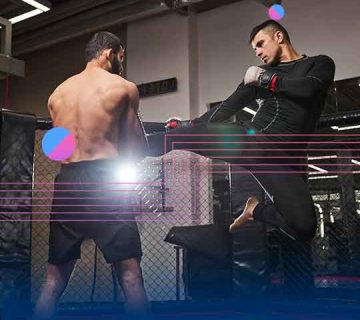Nutrition for Martial Arts
In today’s world, a championship can be changed in every 10 milliseconds and athletes sometimes lose their gold medal by losing a point. Paying attention to all the factors that influence an athlete’s championship and health is crucial.
Undoubtedly, one of the most important factors affecting the performance of athletes, including martial artists, is a proper and basic diet.
Because the way of receiving food affects maintaining the physiological state, improving athletes’ performance and reducing injuries caused by intense training.
Energy production system in martial arts
Energy in the body is created by two systems aerobic and anaerobic. an aerobic energy system by burning carbohydrates and fats will utilize oxygen to produce energy. In moderate and long-term activities, energy is produced through the aerobic system. While in intense and short-term activities, only carbohydrates are required as a fuel source and they burn incompletely. This system of energy production is called anaerobic system.
In the anaerobic system, the blood lactic acid level increases. Findings of a research on athletes of the Brazilian national wushu team showed that the concentration of blood lactate was high during Sanshu style and demonstration talo style, but it was at a higher level in Sanshu style, which indicates that energy is gained through anaerobic in combat sports.
Most martial arts competitions consist of several 2-minute rounds with a one-minute rest between each round. In conclusion, even if several competitions are held during a day, most of the body’s energy is produced through the anaerobic system.
For this reason, high anaerobic strength and capacity, high average aerobic power, and low fat percentage are necessary for a martial artist who fights with her opponent (like judokas).
Those athletes who strike their opponents, such as karateka, taekwondo, and boxers, aerobic capacity, flexibility, average strength, and high anaerobic capacity are important.
Some martial arts, such as Sanshu and Sandai Wushu, are a combination of grappling and striking techniques.
Diet plan for martial artists
Judo and karate athletes who fight in the 50-weight class use approximately 9 kcal per minute energy and wrestlers use 9.3 kcal per minute. These numbers show that the amount of energy is required in these types of sports is almost equal.
According to general recommendations, 60% to 65% of energy intake should be provided from carbohydrates, 12% to 15% from proteins, and 20% to 30% from fats.
Research has shown that martial arts athletes need more minerals and vitamins than the general public. The type of food used in champions is directly related to their type of sport. Studies have shown that few champions follow an optimal eating pattern, consuming too much fat and protein than carbohydrates.
Adequate protein intake, but not too much, is needed for muscle protein synthesis and the repair and creation of blood and immune cells. The American and Canadian Nutrition Association has stated that the amount of protein intake should be 12% to 15% of the daily energy intake, and if the diet has too many or too few calories, it can be 1-1.5 grams per kilogram per day. It is a very good guide.
The importance of drinking enough water in martial artists
In addition, weight class athletes should be careful to avoid the consequences of severe dehydration and never use diuretics, steam baths, and saunas to lose weight before weighing in
At least 48 hours are needed for the body to rehydrate, and dehydration cannot be compensated in the short time between weighing in and competitions.
Martial artists are at risk of malnutrition. Martial artist men and women who compete in weight class martial arts are at the risk of adverse nutritional intake. This issue increases the probability of malnutrition; Therefore, it is recommended not to exclude any food and meals and adjust the diet in such a way that a high amount of carbohydrates, a balanced amount of protein and a small amount of unsaturated fat are consumed. In addition, it is important to consume vegetables, milk and dairy products to get the necessary vitamins, minerals and fiber.
The elite male wushu athletes of the Brazilian national team consumed a high-fat, low-carbohydrate diet, while the women consumed a moderate, high-carbohydrate diet, and energy burning was significantly different in these two groups. These differences in the way of food selection between the two sexes should be considered in the diet recommendation.
Also, a research conducted on karate students showed that the intake of carbohydrates provide 45% of daily energy for men and 46% of daily energy for women, and the intake of fat for men provides 39% of daily energy and 38% of daily energy for women.
For women, exercising a lot and eating less may reduce the basal metabolic rate, and this energy drain can cause irregular periods, the possibility of severe injuries and a decrease in the athlete’s performance. The usual symptoms of exercising too much and eating too little to create an ideal weight are similar to sudden abstinence, which causes mood swings, fatigue, lethargy, anemia, constipation and diarrhea, and decreased libido.




بدون دیدگاه